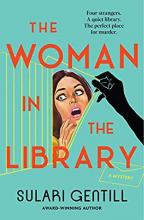The Woman in the Library, Sulari Gentill
The Wikipedia definition of metafiction is:
"Metafiction is a form of fiction which emphasises its own constructedness in a way that continually reminds the audience to be aware they are reading or viewing a fictional work. Metafiction is self-conscious about language, literary form, and story-telling, and works of metafiction directly or indirectly draw attention to their status as artifacts."
It's a notoriously difficult style to execute, and compelling and very clever when done well - and Sulari Gentill is proving herself a very dab hand at the art. THE WOMAN IN THE LIBRARY is cleverly constructed, with an interwoven narrative that I couldn't help feeling expanded on the structure that she came up with for CROSSING THE LINES (aka After She Wrote Him).
Stories within stories are part of both of those novels, and the lines in this outing slightly more defined in that an Australian Author, Hannah, is writing a murder mystery, guided in part by her correspondence with a fan, and aspiring American author, Leo. In Hannah's developing manuscript - which is the main thread through this novel - Australian author 'Freddie' Winifred is in Massachusetts, courtesy of the largess of a writers' scholarship, when she becomes embroiled in a murder which takes place in the Boston Public library, whilst she's in attendance, and in the process of meeting the 3 other main characters in Boston - psychology student Marigold, law student Whit and published author Cain. They are all seated near each other when a scream disturbs the normal serene setting of the Reading Room.
As the story of that investigation, and those of Freddie and her three new friends (and potential romantic interest), play out, at the end of each chapter of the manuscript, Leo contributes his thoughts and ideas on the manuscript back to Hannah as feedback in emails, the tone of which changes disturbingly as the novel progresses.
Playing on the theme of a locked room mystery as well, the switching backwards and forwards between Freddie's manuscript, Leo's increasingly imperious input, the fates of Whit and Cain which become tainted, and threatened all at once, and the part that Marigold has to play in the fictional mystery switch focus, until this reader was utterly immersed in the fictional narrative, versus the actual real lives of Leo and Hannah (which are still fictional let's face it) and the threat that's building there, alongside enough touches of the reality of out of control bushfires, COVID restrictions and BLM protests. Of course it's also possible that the metafictional aspects become overwhelming and a reader could be forgiven for developing a need for notes in "reality / fictional stream 1 / fictional stream 2 / who knows" columns.
Of course, all of this is done with Gentill's normally light hand, touches of humour and a sneaking sense that she's had an awful lot of fun developing this novel - or at the very least jolly well deserves to have done so.
Fans of her better known Rowland Sinclair novels might find this (and CROSSING THE LINES) a dauntingly large step away from the historical settings, and the traditional investigative stylings of that series, but there's enough of the tone and sensibility in both sets of novels for fans of Gentill's writing to feel comfortable. Of course there is the possibility that the bamboozlement of the who what when where errr factors of the metafiction stylings might get to you, but this reader was intrigued, tantalised, amused beyond belief and thoroughly invested in one, all or more of the threads by the end.
In every person's story, there is something to hide...
The ornate reading room at the Boston Public Library is quiet, until the tranquility is shattered by a woman's terrified scream. Security guards take charge immediately, instructing everyone inside to stay put until the threat is identified and contained. While they wait for the all-clear, four strangers, who'd happened to sit at the same table, pass the time in conversation and friendships are struck. Each has his or her own reasons for being in the reading room that morning―it just happens that one is a murderer.


The only other crime metafiction I have read was "The Face on the Cutting Room Floor", which I thought was dreadful. (I'm off the fence).
It was far too clever for its own good.
I will try this one instead. Thanks for the review.